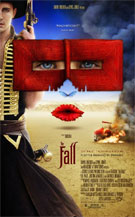A strange, serious fairytale of sorts, The Fall doesn’t really have much in the common with movies in the whiz-bang, skin-deep, post-modern sense of the word. It resembles more the earliest “movies” – skeletal and simple. a series of images sewn together with the most delicate of narratives. The story itself isn’t really the point; it’s how the story is told, through words and especially through pictures. It’s a difficult balancing act, but The Fall, for all its fantastical imagery, manages to keep all its oranges in the air at once and rewards the patient audience with a gentle, heartbreaking story about unlikely friendships spun out of cruel deception.
On the surface, the film is about 5 year old Alexandria (Catinca Untaru), an immigrant girl who broke her arm picking oranges in the field, and is recuperating in a Los Angeles hospital, circa 1915. A fellow hospital mate is Roy (Lee Pace), a Hollywood stuntman who’s become paralyzed after a foolish stunt. Alexandria is foolishly curious and her English is poor, but she strikes up a friendship with the dour Roy anyway, who, as it turns out, is suicidal after losing his girlfriend to an early Hollywood jerk type. In a con to gain Alexandria’s trust, he begins telling her a fantastical story about colorful 5 bandits hungering for revenge against an evil governor.
She is immediately entranced by the story, which jumps deftly from a butterfly shaped island to an orange colored desert inhabited by a tree-dwelling mystic to an incredible labyrinth without exit to the majestic bridges of Prague without a pause. The Fall suggests that the story we see on the screen is not strictly being created out of Roy’s words, but what those words mean when filtered through Alexandria’s imagination. Roy tells her that the bandits include an Indian, who has locked his beautiful Squaw in a Wigwam. Alexandria doesn’t understand these words as they are, so the feathered Native American Western Roy pictures becomes an Indian, his squaw a veiled Arab princess, and the Wigwam akin to the Taj Mahal.
Indelibly reality begins to bleed into this fantastical world Roy and Alexandria share. The Fall takes many of its cues from The Wizard of Oz here, borrowing faces from the realm of the real and transposing them into the colorful world of the tale. Roy becomes a bandit in a red silk mask; a pretty nun (Justine Waddell) becomes a treacherous princess; a doctor is Charles Darwin (Leo Bill) in a bowler hat and ladybug coat. But even the most beautiful of dream worlds are beholden to the changing shape of the reality that creates them. Mostly through whispered half conversations that sound like gibberish to her untrained ear Alexandria overhears but doesn’t quite understand that Roy has a dark purpose of his own. It is selfishly spiteful in the way the actions of a suicidal person can be, but the smitten Alexandria cares only for what happens next in the story.
What does happen next? This is the question propels the narrative along to its conclusion, though it is never quite answered. At the end of The Fall, the audience might ask themselves if the whole endeavor was meaningless. Is a story with no end – or worse, a false end – worth telling at all? The true meaning of the film, as I interpret it, is wholly in its telling. The interaction between what words say (denotation) and what they mean (connotation) is constantly at play in The Fall, visually demonstrated through the juxtaposition of a an illusory, jewel-toned dream world and the real: a sloppy, monochromatic, unbearably unfair world. When Alexandria is displeased with how the depressing Roy is steering the narrative she takes charge. “It’s my story, too,” she says and voila, it is.
Director Tarsem Singh made his way up the ladder with commercials for sneakers, but never falls prey to the quick-cut horribleness that mars the films of his contemporaries. Singh is Indian, and shines a multihued prism on his films, filling them with richness not found in most Western pictures, except for those of Julie Taymore (who’s surrealistic Frida dream sequences is referenced here). He takes his time with the camera; slowly panning over the splendid landscapes he has created to let the viewer soak in the richness of his palette, the diversity of his vision.
It is worth mentioning that The Fall is untouched by CG imagery, which doesn’t mean the visuals are boring or unbelievable to our modern eyes. Like those early silent films, which amazed and frightened audiences with their unimagined potential for the fantastic, The Fall uses special effects to heighten reality in subtler, more intriguing ways. It is the kind of movie that would be wasted on a miniscule television screen; its visuals are the heart of the thing and require theatrical treatment to reveal their full depth.
Your Daily Blend of Entertainment News

